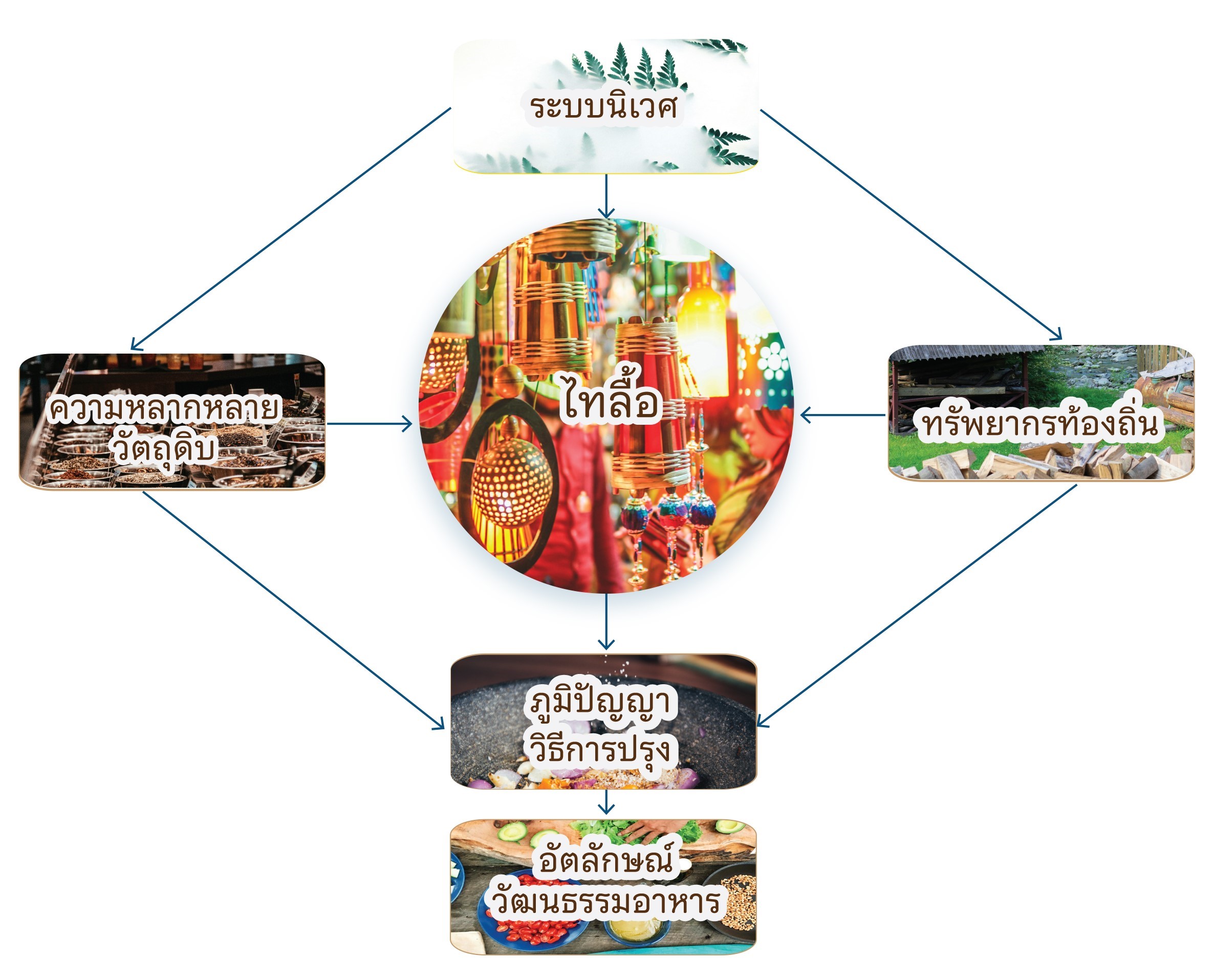The Food in The Way of Life Related to The Local Cultural Ecosystem of The TaiLue Ethnic Group in Ban Na Yang Tai, Nam Bak District, Luang Prabang Province, Lao People's Democratic Republic
Main Article Content
Abstract
This research article aims to survey the food in the way of life related to the cultural ecology of the Tai Lue ethnic group in Ban Na Yang Tai, Nam Bak District, Luang Prabang Province. This is qualitative research using observation and interviews with a target group of 20 people by purposive selection. The data were examined, analyzed, and presented descriptively.
The results revealed that: the food that is popularly prepared with natural ingredients can be divided into 10 categories: 1) Laab, 2) Roasted, 3) Boiled, 4) Curry, 5) Nam Phrik, 6) Eaw, 7) Soup, 8) Mok, 9) Desserts, and 10) Others. These foods are related to the local settlement ecosystem in the plains surrounded by mountains. There are marshes flowing through the community and agricultural areas all year round, resulting in moisture suitable for growing a variety of plants, especially rice and vegetables. However, many plants grow naturally and can be used in cooking all year round. As for meat, fish is the main food. Large meat is popular in traditional festivals. The popular food is Laab. As for the seasoning, crab paste is used instead of fermented fish. Tai Lue people do not like to eat sweet foods in their daily lives. Sweet dishes are only served at important religious ceremonies or events.
Article Details

This work is licensed under a Creative Commons Attribution-NonCommercial-NoDerivatives 4.0 International License.
เพื่อให้เป็นไปตามกฎหมายลิขสิทธิ์ ผู้นิพนธ์ทุกท่านต้องลงลายมือชื่อในแบบฟอร์มใบมอบลิขสิทธิ์บทความ ให้แก่วารสารฯ พร้อมกับบทความต้นฉบับที่ได้แก้ไขครั้งสุดท้าย นอกจากนี้ ผู้นิพนธ์ทุกท่านต้องยืนยันว่าบทความ ต้นฉบับที่ส่งมาตีพิมพ์นั้น ได้ส่งมาตีพิมพ์เฉพาะในวารสาร วิชาการธรรม ทรรศน์ เพียงแห่งเดียวเท่านั้น หากมีการใช้ ภาพหรือตารางของผู้นิพนธ์อื่นที่ปรากฏในสิ่งตีพิมพ์อื่นมาแล้ว ผู้นิพนธ์ต้องขออนุญาตเจ้าของลิขสิทธิ์ก่อน พร้อมทั้ง แสดงหนังสือที่ได้รับการยินยอมต่อบรรณาธิการ ก่อนที่บทความจะได้รับการตีพิมพ์References
ธิติ ไวกวี. (2562). ขนมดอกซ้อแห่งภูมิปัญญาไทลื้อ (พะเยา): กระบวนทัศน์การสร้างโมเดลทางกฎหมายเพื่อฟื้นฟูและอนุรักษ์ทรัพยากรชีวภาพชุมชน. วารสารนิติ รัฐกิจ และสังคมศาสตร์, 3(2), 87-123. https://so06.tci-thaijo.org/index.php/lawcrru/article/view/187828/145207
นิชชิมา บุญเฉลียว. (2553). อาหารกับพิธีกรรม: การประดิษฐ์สร้างความทรงจำทางสังคมของชาวลื้อพลัดถิ่นในเชียงคำ จังหวัดพะเยา. วารสารศิลปศาสตร์ มหาวิทยาลัยสงขลานครินทร์, 2(2), 107-132. https://so03.tci-thaijo.org/index.php/journal-la/article/view/93789/73440
ปิยะนาฎ จันทร์กระจ่าง, ศิริเพ็ญ เยี่ยมจรรยา และเอกกวีร์ วินิจเขตคําณวน. (2567). การพัฒนาอาหารพื้นถิ่นและวิเคราะห์คุณค่าทางโภชนาการสู่สํารับอาหารเพื่อการท่องเที่ยวชุมชนไทลื้อหมู่บ้านหาดบ้าย จังหวัดเชียงราย. วารสารวิทยาลัยดุสิตธานี, 18(1), 1-12. https://so01.tci-thaijo.org/index.php/journaldtc/article/view/271531/176275
เปลวเทียน เจษฎาชัยยุทธ์ และอมรฉัฐ เสริมชีพ. (2564). “ไค” พืชภูมิปัญญาท้องถิ่นสู่การกลายเป็นอาหารอัตลักษณ์ในเมืองมรดกโลกหลวงพระบาง และผลกระทบจากการพัฒนา. วารสารมนุษยศาสตร์และสังคมศาสตร์ มหาวิทยาลัยบูรพา, 29(2), 135-159. https://so06.tci-thaijo.org/index.php/husojournal/article/view/249094/169769
สถาบันวิจัยสังคม มหาวิทยาลัยเชียงใหม่. (2553). วัฒนธรรมอาหารในงานประเพณีของชาวไทลื้อ. (รายงานการวิจัย). เชียงใหม่: มหาวิทยาลัยเชียงใหม่.
สมใจ แซ่โง้ว และวีระพงค์ มีสถาน. (2541). สารานุกรมกลุ่มชาติพันธุ์ไทยลื้อ. กรุงเทพฯ: สถาบันวิจัยภาษาและวัฒนธรรมเพื่อพัฒนาชนบท มหาวิทยาลัยมหิดล.
เสาวภา ศักยพันธ์. (2558). วัฒนธรรมอาหารไทลื้อในอนุภูมิภาคลุ่มน้ำโขง: ไทย จีน พม่า และลาว. (รายงานการวิจัย). กรุงเทพฯ: กรมส่งเสริมวัฒนธรรม กระทรวงวัฒนธรรม.
องค์การกองทุนสัตว์ป่าโลกสากล ประเทศไทย (WWF Thailand). (2564). ข้อมูลทั่วไปของแม่น้ำโขง. เข้าถึงได้จาก http://www.wwf.or.th/what_we_do/wetlands_ and_production_landscape/mekongriver
อนุกูล ตันสุพล. (2559). กุญแจสู่การพัฒนาที่ยั่งยืน: นิเวศวิทยาวัฒนธรรม. วารสารวิชาการคณะมนุษยศาสตร์และสังคมศาสตร์ มหาวิทยาลัยสงขลานครินทร์, 12(1), 193-221. https://so03.tci-thaijo.org/index.php/eJHUSO/article/view/82628/65660
